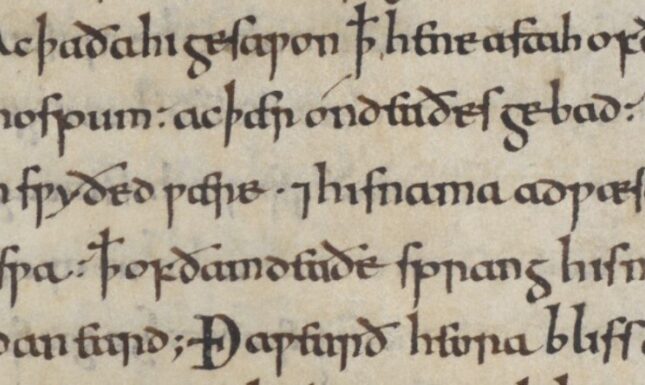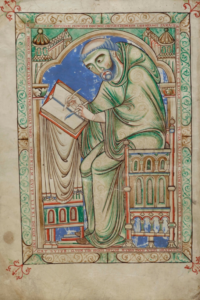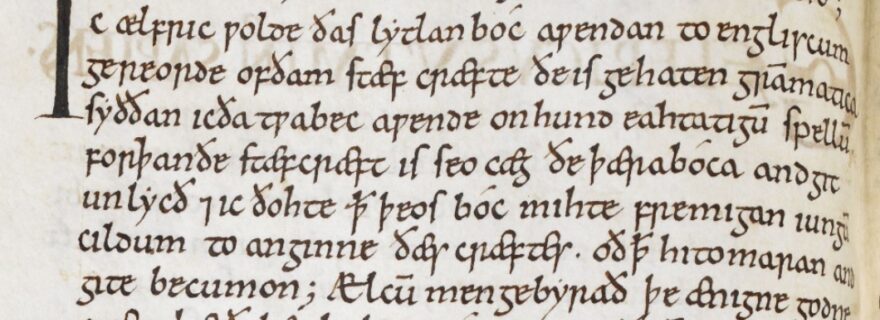Medieval Copying Gone Wrong? The Importance of Scribal Interference
How did medieval scribes copy manuscripts and what can manuscript copies tell us about language development? Amos van Baalen introduces his NWO-funded PhD project.
Our modern idea of the concept of ‘copying’ cannot be applied indiscriminately to the Middle Ages. In the age before the printing press, the reproduction of texts was a human effort, which rested in the hands of individual scribes. Although these scribes were required to copy their exemplars as accurately as possible, this did not always happen, as scribes could make mistakes or even introduce their own alterations. For texts whose transmission spans multiple centuries, these apparent mistakes or alterations can provide invaluable information about language change.
‘If anyone wishes to copy this book’: Admonitions of medieval authors
People in the Middle Ages were no different from their modern counterparts in that the correct reproduction of books, especially books of religious importance, was seen as something to strive for. In his Latin poem ‘On Scribes’, the English scholar Alcuin of York (c. 740–804) admonishes scribes to “take care not to insert their silly remarks” and that “their hands not make mistakes through foolishness” (trans. Godman, 1985). Another English scholar, Ælfric of Eynsham (c. 955–c. 1010), one of the most prolific writers of Anglo-Saxon England, included explicit warnings in a number of his works which stated that anyone who wanted to copy his texts had to take care to do so correctly. The following extract, taken from the preface to his first series of Catholic Homilies, is a representative example of such an exhortation:
Nu bydde ic 7 halsige on godes naman gif hwa þas boc awritan wylle þæt he hi geornlice gerihte be ðære bysene. þy læs ðe we ðurh gymelease writeras geleahtrode beon. Mycel yfel deð se ðe leas writ. buton he hit gerihte. swylce he gebringe þa soðan lare to leasum gedwylde. for ði sceal gehwa gerihtlæcan þæt þæt he ær to woge gebigde gif he on godes dome unscyldig beon wile.
[Now I ask and implore in the name of God, if anyone wishes to copy this book, that he diligently correct it according to the exemplar, lest we be reproved through (the actions of) careless writers. Much evil does the one who writes falsely, unless he corrects it, as if he brings the true teaching to false error. Therefore, every person must rectify that which he earlier turned to error, if he wishes to be innocent in God’s judgement.]
Although this admonition sounds serious, it is fairly tame when compared to some of the more severe threats of bodily harm that were made against scribes if they did not copy their texts correctly (for examples, see the blogpost 'Scribal abuse in the Middle Ages' by Thijs Porck). Despite warnings such as this one in the prefaces to his major works, we shall see that actual scribes often did not heed Ælfric’s words.
Actual scribal practice: Adapting and changing texts
Medieval scribes could certainly copy their exemplars letter-by-letter, but many adapted the text they were copying to varying degrees, so that the copy they were producing was closer to their own language use (see Laing, 2004). The works of the aforementioned Ælfric provide excellent examples of this type scribal alteration, since they were copied over a period of about 200 years (c. 1000–c. 1200). The following two equivalent passages of one his Catholic Homilies illustrate some of the changes that exist between early and late copies of his texts. The first passage is taken from a manuscript from c. 990 that was used by Ælfric himself:


Ac þa ða hi gesawon þæt he ne astah of ðære rode for heora hospum; ac þær on deaðes gebad; þa gelyfdon hi þæt he oferswyðed wære. and his nama adwæsced. ac hit gelamp swa; þæt of ðam deaðe sprang his nama geond ealne middaneard;
[But when they saw that he did not come down from the cross because of their taunts, but waited for death on it, then they believed that he had been overcome, and his name erased. But it happened in such a way, that from (his) death, his name spread throughout the whole world.]
The equivalent passage in a manuscript from the second half of the twelfth century, more than 150 years after the text’s original composition, reads as follows:
Ac þa ða heo iseawon þæt he ne astah of ðære rode for heora hospum ac ðer on dæðes abad. þa lyfdon heo þæt he ofercumon wæro. and his namæ adwescod. Ac hit ilamp swa þæt of þam dæðe alsprang his name geond alne middæneard.
Although the two excerpts may look very similar at first glance, there are a number of differences between them. For instance, the Old English prefix ge- in the early copy (e.g., in the verbs “gesawon” [seen] and “gelamp” [happened]) is rendered as i- in the late copy (“iseawon” and “ilamp”), or may even disappear completely (“gelyfdon” vs “lyfdon” [believed]). One word has even been replaced: whereas the tenth-century original uses “oferswyðed” [overcome], the twelfth-century scribe has replaced it with “ofercumon”. Ælfric would certainly not have appreciated these alterations to his text, but we most certainly should, since they provide us with important information about the development of the English language.
Scribal alterations and their importance for studying language change
Rather than regarding the changes mentioned above as ‘corruptions’ or ‘incorrect versions of the authorial text’, these alterations can tell us a great deal about linguistic change. For instance, the replacement of the prefix ge- with i- in words such as “gelamp” tells us that the pronunciation of this prefix had changed in the time period between the copying of the two manuscripts. Furthermore, the replacement of the verb “oferswyðed” with “ofercumon”, the direct ancestor of Present-Day English overcome, may be a sign that the verb oferswīðan was seen as archaic or was perhaps no longer understood by the later scribe.

I will be studying these particular changes for my NWO-funded PhD project ‘Old English Renewed: Tracing Transitional English in the Twelfth Century’. The focus on the twelfth century is due to its importance in the history of the English language: this century is traditionally seen as the period in which Old English became Middle English, two historical stages of English which show significant differences in terms of their sounds, grammar, and vocabulary. Sadly, twelfth-century English has been difficult to study due to the lack of new compositions in this period. This lack of new texts was a result of the Norman Conquest of England in 1066 and the subsequent replacement of Old English with Latin and Anglo-Norman as the prestigious written languages. For this reason, the project will focus on the digital analysis of sources which have not yet received the attention they deserve: later manuscript copies of Ælfric’s Catholic Homilies. Since these homilies were copied continuously between c. 1000 and c. 1200, the alterations made by later scribes can tell us about the state of the English language in the twelfth century, and may finally shed some light on this obscure period in the history of English. In this respect, we should be grateful that medieval scribes were not as meticulous as they could have been.
Further Reading
- Godman, P. (1985). Poetry of the Carolingian Renaissance. Duckworth.
- Laing, M. (2004). Multidimensionality: Time, space and stratigraphy in historical dialectology. In M. Dossena & R. Lass (Eds.), Methods and data in English historical dialectology (49–96). Peter Lang.
© Amos van Baalen and Leiden Medievalists Blog, 2021. Unauthorised use and/or duplication of this material without express and written permission from this site’s author and/or owner is strictly prohibited. Excerpts and links may be used, provided that full and clear credit is given to Amos van Baalen and Leiden Medievalists Blog with appropriate and specific direction to the original content.


